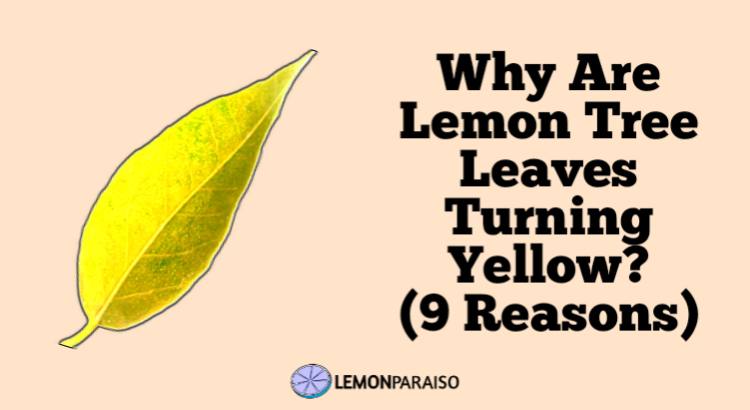Lemon Tree Drooping Leaves: Causes And How To Fix Them
Lemon trees, with their vibrant green foliage and zesty fruits, are a delight for any gardener. However, the sight of drooping leaves can be a cause for concern, hinting at underlying issues affecting the health of your lemon tree. In this comprehensive guide, we’ll explore ten common reasons behind lemon tree drooping leaves and provide insights into how you can address each issue to restore your tree to its full glory.
Lemon Tree Drooping Leaves (10 Reasons Why)
1. Watering Woes:
Lemon trees are sensitive to both under and over-watering. Inconsistent watering can lead to stress, resulting in drooping leaves. Ensure a regular watering schedule and monitor soil moisture to maintain optimal conditions for your lemon tree.
Overwatering can lead to root rot, a common problem in lemon trees. If you observe drooping leaves accompanied by yellowing and a foul odor from the soil, it’s crucial to adjust your watering practices promptly.
2. Soil Quality:
The health of a lemon tree is closely tied to the quality of the soil it’s planted in. Poorly drained soil or soil lacking essential nutrients can contribute to drooping leaves. Conduct a soil test to identify deficiencies and amend the soil accordingly with organic matter or specialized fertilizers.
Additionally, compacted soil can impede proper root growth, limiting the tree’s ability to absorb nutrients. Regularly aerate the soil to promote a healthy root system and alleviate issues related to soil compaction.
3. Pests and Diseases:
Insects such as aphids, scale, and spider mites can infest lemon trees, causing stress and leaf drooping. Regularly inspect your lemon tree for signs of pests and treat them promptly with insecticidal soaps or neem oil.
Fungal diseases, such as citrus canker or powdery mildew, can also contribute to drooping leaves. Apply fungicides as a preventive measure and ensure proper spacing between trees for adequate air circulation.
4. Temperature Extremes:
Lemon trees thrive in moderate temperatures, and extremes on either end can lead to leaf drooping. Frost can damage the leaves, while scorching heat can cause stress. Consider protective measures during temperature extremes, such as covering the tree in winter or providing shade in summer.
Container-grown lemon trees are especially susceptible to temperature fluctuations. Move potted lemon trees to a sheltered location during harsh weather conditions.
5. Nutrient Deficiency:
A lack of essential nutrients, particularly nitrogen, potassium, and magnesium, can result in drooping leaves. Fertilize your lemon tree regularly with a balanced citrus fertilizer to ensure it receives the necessary nutrients for healthy growth.
Pay attention to yellowing leaves, as this can be an indicator of specific nutrient deficiencies. Adjust your fertilizer regimen based on the specific needs of your lemon tree.
6. Root Issues:
Problems with the root system, such as root rot or circling roots, can impact the tree’s ability to absorb water and nutrients. Inspect the root ball when planting or transplanting, and trim any circling roots to encourage proper growth.
Avoid planting lemon trees too deep, as this can lead to suffocation of the roots. Maintain proper planting depth and consider root barriers for container-grown lemon trees.
7. Improper Pruning:
Pruning is essential for shaping and maintaining the health of a lemon tree, but improper pruning can stress the tree and lead to drooping leaves. Follow proper pruning techniques, removing dead or diseased branches and promoting an open canopy for sunlight penetration.
Avoid excessive pruning, especially during periods of active growth, as this can shock the tree. Prune strategically during the dormant season for optimal results.
8. Inadequate Sunlight:
Lemon trees require ample sunlight for photosynthesis and overall well-being. Insufficient sunlight can lead to weak growth and drooping leaves. Ensure your lemon tree receives at least 8 hours of direct sunlight daily.
If your tree is planted in a shaded area, consider transplanting it to a sunnier location. Container-grown lemon trees can be moved to sunlit spots for better exposure.
9. Chemical Exposure:
Exposure to chemicals, whether from nearby construction, herbicides, or pesticides, can negatively impact lemon trees. Symptoms may include drooping leaves, discoloration, and overall poor health. Limit chemical exposure by creating a protective barrier and avoiding the use of harmful chemicals in close proximity to your lemon tree.
If chemical exposure is suspected, thoroughly irrigate the soil to flush out potential contaminants and consider applying activated charcoal to neutralize any residual toxins.
10. Stress from Transplanting:
Lemon trees can experience stress when transplanted, leading to drooping leaves as they acclimate to their new environment. Minimize transplant shock by watering thoroughly before and after transplanting, and provide temporary shade to reduce stress.
Gradual acclimatization is key to successful transplantation. Introduce the tree to its new location slowly, allowing it to adjust to changes in sunlight, temperature, and soil conditions.
In conclusion, addressing the specific cause of drooping leaves in your lemon tree requires careful observation and a targeted approach. By considering these ten common factors and implementing the suggested solutions, you can rejuvenate your lemon tree and ensure it continues to thrive, providing you with abundant harvests of delicious, tangy fruits.


